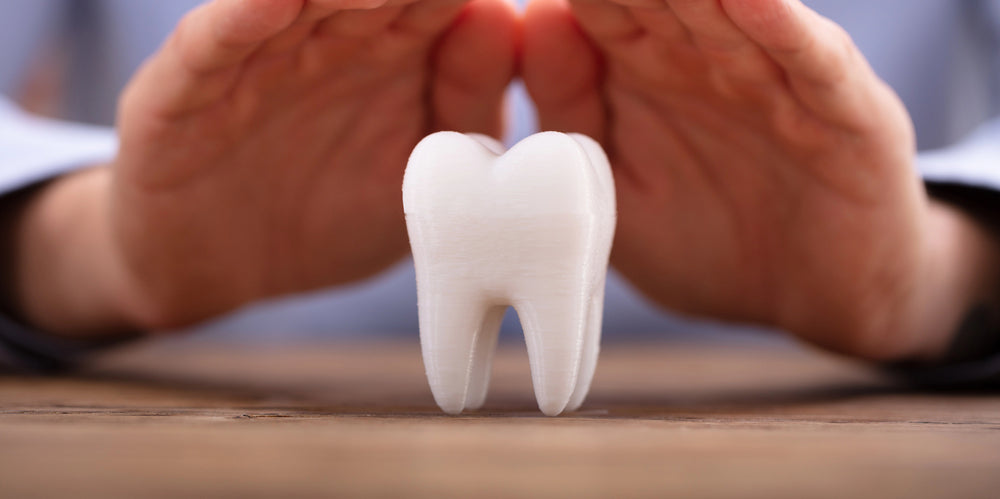
What is Tooth Enamel and Why is it Important?
|
Time to read 5 min
|
Time to read 5 min
A radiant smile is a powerful asset, capable of leaving a lasting impression. At the forefront of maintaining oral health lies a remarkable component of our teeth called tooth enamel. Often referred to as the "guardian" of our teeth, the enamel is a hard, mineralized substance that covers the outer layer of our teeth.
Tooth enamel is the hardest substance in the human body, even tougher than bone. It covers the visible part of the tooth, known as the crown, and acts as a shield for the softer layers below, dentin and pulp, which house sensitive nerves and blood vessels. The enamel is composed of minerals, primarily hydroxyapatite (the natural mix of calcium and phosphorus that makes up your bones).
Enamel’s job is to preserve the structure of teeth and ensuring their longevity. Beyond this protective role, enamel also contributes to the aesthetics of our smiles. The yellowing of our teeth as we age is not just due to staining but is also a sign of the thinning of your enamel. As it thins, then the underlying dentin, which is naturally yellowish, shines through, giving teeth a yellowing look. Maintaining tooth enamel's integrity is important for both a radiant smile and overall oral well-being.
Have you ever wondered what the main function of enamel is and why is enamel important for your teeth? In this article, we will discuss all the details about what tooth enamel is as well as what it does.
Enamel’s main job is to protect your teeth from damage, like chewing or biting, clenching, and grinding as well as the major threat of acidic foods and acids produced by bacteria in your mouth.
Enamel also provides your teeth with protection from sensitivity or pain due to temperatures and chemicals. When it erodes, from acids and such, you may be more sensitive to cold or hot foods or drinks, as well as sweets, as they can now travel through the cracks, or minute holes, in your enamel to the nerves.
Enamel cannot be regrown. Once enamel is lost, it cannot regenerate, leaving the tooth vulnerable to further decay and increased sensitivity. That is why it is so important to take preventive measures to preserve and protect your enamel.
What is Enamel Made Of?
Enamel is composed of mostly hydroxyapatite, which is a blend of calcium and phosphorus that have formed rigid crystalline structures. Then, proteins constitute approximately 1% of enamel, while water makes up another 4%. Two things that you won’t find in enamel are nerves or a blood supply.
Discover More: Why Do My Teeth Hurt When I'm Sick
What Does Enamel Look Like?
Enamel is a hard, translucent outer layer that covers the visible part of the tooth. It appears as a smooth, shiny, and greyish-white to light yellow surface. Enamel is highly mineralized and protects the underlying dentin and pulp of the tooth.
Healthy enamel, basically healthy teeth, will have a smooth and glossy appearance. Its natural color tends more towards a bluish-white.
Can You Regrow Enamel?
Unfortunately, enamel cannot be regrown and does not heal or regenerate. Perhaps, at some future date, scientists will figure out how to do that but for now it is important to take good care of your teeth, especially the protective enamel.
One restorative option, however, is to remineralize your enamel by using toothpastes that help restore minerals back into the enamel’s surface and even mineralizing down into the enamel as well. High-quality nano-hydroxyapatite toothpastes will do this job as they have been specifically engineered to deliver hydroxyapatite back into the enamel’s structure.
One should look for toothpastes that are high in hydroxyapatite and nano-hydroxyapatite (minimum 10%) and not simply token amounts with high levels of fillers, such as glycerine. These toothpastes can help tremendously to add back minerals to damaged enamel, bringing natural whitening, decreasing sensitivity and bolstering the strength of your protective layer of enamel.
Effective bad breath remedies include:
Gentle and regular scraping of the tongue
Regular oral care practices such as daily brushing and flossing
Professional deep cleanings and plaque removal
The ongoing use of oral probiotics.
One, the probiotics compete with the existing bad bacteria and reduce their presence by “crowding them out”
Two, the probiotics produce BLIS or “bacteriocin-like-inhibitory-substances” which is a technical way of stating that one probiotic strain (bacteria) can produce a substance that inhibits or kills off other bacteria. Three, by working to control gingivitis, gum disease and tooth decay these probiotics reduce the very sources of bacteria-generated odors in the mouth.
Studies have shown a clear reduction in plaque levels and gingivitis symptoms when oral probiotics were administered to patients with moderate to severe gingivitis.


